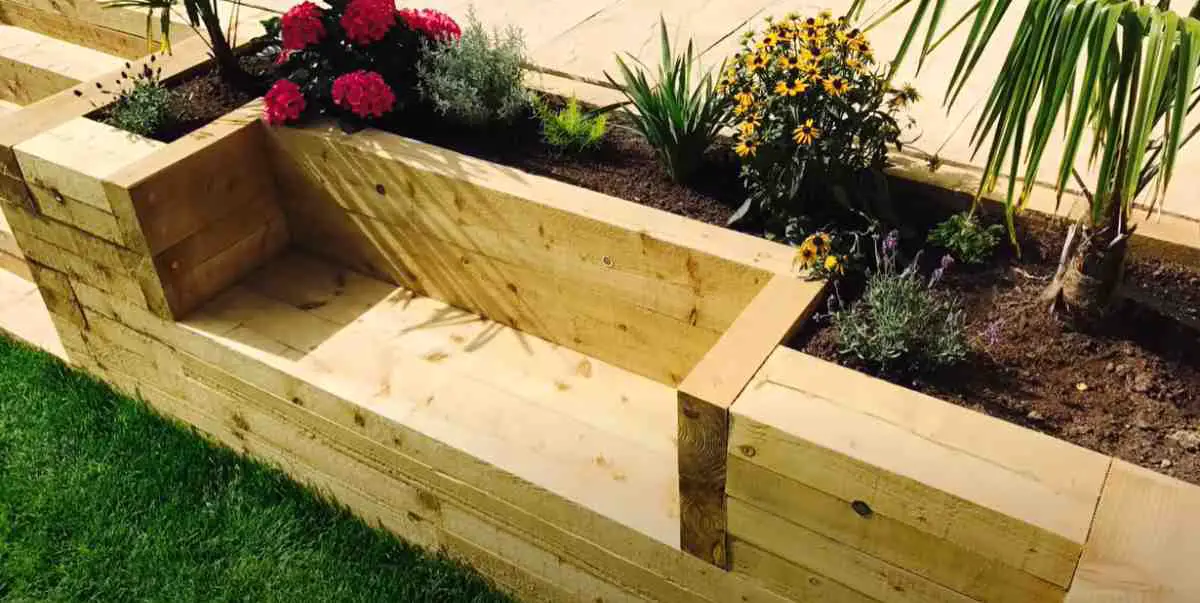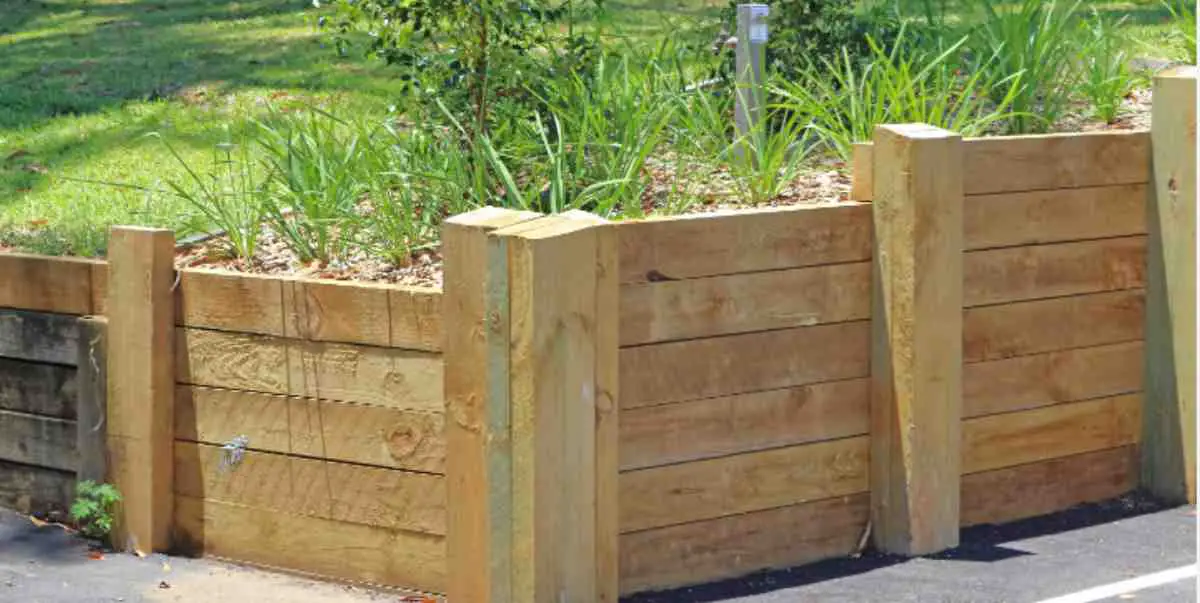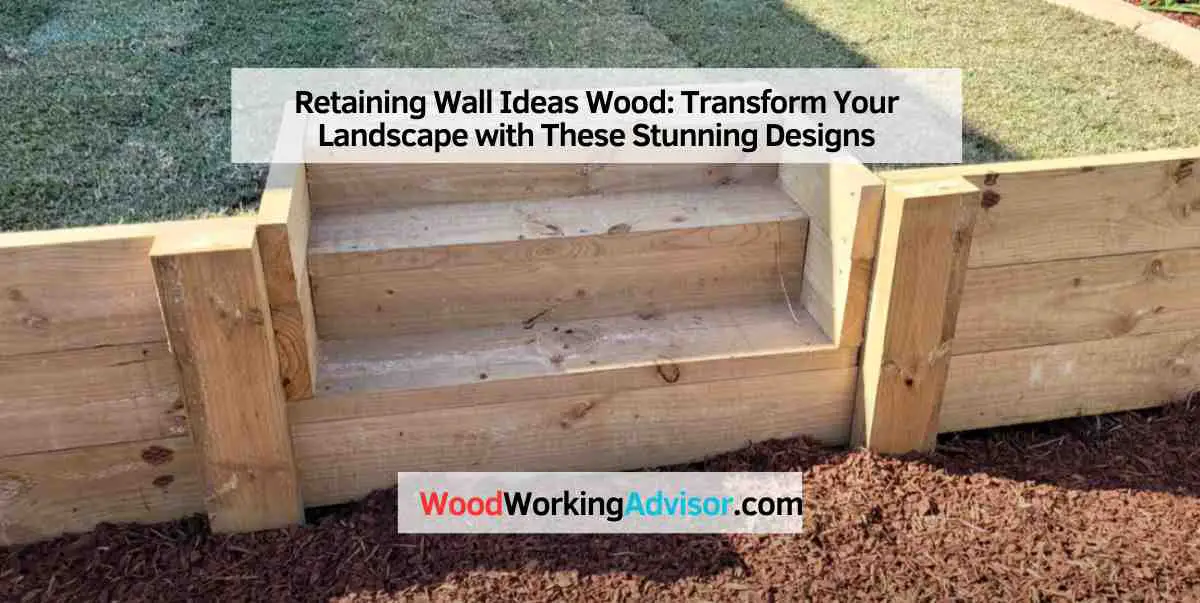For wood retaining wall ideas, consider using cedar or redwood for durability and a natural look. These materials can complement your landscape and provide a lasting solution for soil retention.
Whether you want a rustic or modern aesthetic, wood retaining walls can be customized to fit your style and budget. With proper construction and maintenance, they can also add value to your property. Additionally, incorporating unique design elements like vertical gardens or integrated seating can enhance the function and visual appeal of your wood retaining wall.
Be sure to consult with a professional to ensure the structural integrity and longevity of your wooden retaining wall.
Benefits Of Wood Retaining Walls
Wood retaining walls offer a myriad of benefits that make them a popular choice for landscaping and soil retention projects. From their durability and strength to their natural aesthetic appeal, wood retaining walls provide both functional and visual advantages for any outdoor space.
Durability And Strength
Wood retaining walls are known for their strength and durability. When properly constructed with high-quality timber, they can withstand the pressure of the soil and keep the landscape intact for a long period. This durability ensures that the retaining wall will continue to fulfill its purpose over time, providing peace of mind for property owners.
Natural Aesthetic
One of the primary benefits of wood retaining walls is their natural aesthetic. The organic warmth and texture of wood blend seamlessly into outdoor environments, creating a rustic and visually appealing backdrop for gardens, yards, and pathways. The natural beauty of wood enhances the overall landscape, adding charm and character to the surroundings.
In addition to their aesthetic appeal, wood retaining walls can be easily customized to complement various design styles, from traditional to contemporary, making them a versatile choice for any outdoor space.

Types Of Wood For Retaining Walls
Pressure-treated Wood
Pressure-treated wood is a cost-effective choice for retaining walls due to its durability.
Cedar And Redwood
Cedar and redwood provide a natural and aesthetically pleasing option for retaining walls.
Tropical Hardwoods
Tropical hardwoods, such as ipe and balau, offer a luxurious and long-lasting solution for retaining walls.
Design And Construction Considerations
When it comes to designing and constructing a wood retaining wall, there are several important considerations to keep in mind. These considerations are crucial in ensuring the stability, functionality, and longevity of your retaining wall. In this section, we will explore the design and construction considerations that you should take into account for your wood retaining wall project.
Height And Slope Considerations
One of the first design considerations for your wood retaining wall is its height and slope. The height of the wall will determine its overall stability and effectiveness in holding back soil and preventing erosion. Additionally, the slope of the wall plays a significant role in its ability to withstand lateral pressure and maintain its structural integrity.
When determining the height and slope of your wood retaining wall, it is essential to consider the load it will bear, the type of soil it will retain, and any potential water accumulation behind the wall. These factors will influence the dimensions, material selection, and reinforcement requirements of your retaining wall.
Drainage And Backfilling
Proper drainage and backfilling are critical factors in the construction of a wood retaining wall. Without adequate drainage, water can accumulate behind the wall, increasing hydrostatic pressure and compromising its stability. To prevent this, it is important to incorporate drainage provisions into the design and construction of the wall.
Backfilling, on the other hand, refers to the material placed behind the retaining wall. It should be carefully selected and properly compacted to enhance drainage, promote soil stability, and minimize the risk of settlement. Moreover, the backfill material should be free from debris, rocks, and excessive organic matter, as these can cause uneven pressure distribution and potential damage to the wall.
Anchor Systems
Anchor systems play a crucial role in enhancing the stability of your wood retaining wall. These systems help to counteract the lateral forces exerted on the wall and prevent it from toppling or leaning. There are various types of anchor systems available, including deadman anchors, geogrids, and helical anchors.
Incorporating appropriate anchor systems into your retaining wall design ensures its long-term stability, especially in areas prone to soil erosion and unpredictable weather conditions. It is crucial to consult with a professional engineer or contractor to determine the most suitable anchor system for your specific wood retaining wall project.
Stunning Wood Retaining Wall Designs
Wood retaining walls can add a touch of rustic charm and natural beauty to any outdoor space. With their warm tones and organic textures, they create a stunning visual statement while holding back soil and preventing erosion. If you’re looking for creative ideas to elevate your landscaping, we’ve got you covered!
Tiered Garden Walls
One fantastic option to consider is incorporating tiered garden walls made of wood. These structures are not only functional but also offer an opportunity to showcase your favorite plants and flowers in an eye-catching way. By carefully choosing the height and position of each tier, you can create a cascading effect that adds depth and visual interest to your garden.
Here are some key features and benefits of tiered garden walls:
- • Versatile design that fits well in any landscape
- • Creates multiple sections for planting and landscaping
- • Provides a natural transition between different garden levels
- • Adds dimension and a sense of movement to your outdoor space
Curved Wood Walls
Another captivating design idea for a wood retaining wall is incorporating curved shapes. By introducing gentle curves into the structure, you can soften the overall look and create a more organic and flowy feel. Curved wood walls can enhance the aesthetics of your landscaping, making your outdoor space feel more inviting and unique.
Here are some reasons why curved wood walls are worth considering:
- • Creates a stunning focal point in your yard
- • Enhances the natural flow of your landscape design
- • Adds visual interest and breaks up straight lines
- • Helps to blend the retaining wall seamlessly with the surrounding environment
Integrated Seating Walls
Why settle for a plain retaining wall when you can combine both beauty and functionality? Integrated seating walls are a clever way to maximize the usefulness of your outdoor space while still maintaining an attractive look. These walls provide comfortable seating options, making them perfect for entertaining guests or simply enjoying some quiet time in your garden.
Here are some advantages of integrated seating walls:
- • Offers extra seating for gatherings or relaxation
- • Saves space by combining a seating area with retaining functions
- • Allows for creativity in design with various seating arrangements
- • Provides a cozy and intimate atmosphere in your outdoor living area
Wood Retaining Wall Maintenance
Maintaining a wood retaining wall is essential for its longevity and aesthetic appeal.
Sealing And Staining
- Seal your wood retaining wall every 1-3 years to prevent water damage.
- Stain the wood every 2-4 years to maintain its color and protect it from UV rays.
Checking For Rot And Decay
- Regularly inspect the wood for signs of rot, decay, or insect damage.
- Replace any damaged or rotted wood promptly to prevent structural issues.
Incorporating Landscaping With Wood Retaining Walls
When it comes to creating a stunning landscape, incorporating wood retaining walls can be a game-changer. These versatile structures not only provide functional support but also add a warm and natural touch to your outdoor space. With the right landscaping elements, you can further enhance the beauty of your wooden retaining walls. Here are a few ideas to inspire you:
Vertical Gardens
Adding a vertical garden to your wooden retaining wall is a great way to maximize space and bring life to your outdoor area. Vertical gardens are not only visually appealing but also provide several benefits, such as improving air quality and insulation. Consider planting trailing vines, colorful flowers, or even herbs and vegetables to create a stunning and practical display. Be sure to choose plants that suit your climate and require minimal maintenance. Vertical gardens also act as a natural sound barrier, creating a peaceful oasis in your backyard.
Integrating Lighting
Enhance the ambiance of your wood retaining wall by incorporating strategic lighting. Well-placed lighting fixtures can highlight the texture and natural beauty of the wood while adding an enchanting glow to your outdoor space. Consider using LED strip lights or spotlights to accentuate specific areas of the wall. You can also install solar-powered lights for an eco-friendly option. The right lighting can transform your wooden retaining wall into a captivating focal point, creating a cozy and inviting atmosphere for outdoor gatherings.
Adding Water Features
A water feature, such as a fountain or a small pond, can create a soothing and serene atmosphere when combined with a wood retaining wall. The sound of trickling water can help mask unwanted noise and provide a sense of tranquility. Consider incorporating a water feature into your retaining wall design, allowing the water to flow gently down the wooden structure. This fusion of wood and water creates a harmonious and natural look that will captivate your senses. Additionally, water features attract wildlife, such as birds and butterflies, adding an extra element of beauty to your landscape.
Cost Considerations And Budgeting
When installing a wood retaining wall, it’s important to consider the cost implications and budget accordingly. From material costs to labor expenses, understanding the financial aspects is crucial for a successful project. Let’s delve into the key considerations for budgeting when planning a wood retaining wall.
Material Costs
Wood: The type of wood chosen significantly impacts the overall cost. Options range from economical pressure-treated pine to more upscale hardwoods like cedar or redwood.
Fasteners and Connectors: Bolts, nails, and connectors are essential for securing the wood components, adding to the material expenses.
Labor And Additional Expenses
- Labor Costs: Hiring professionals for the installation adds to the overall budget. The complexity and size of the wall will influence the labor expenses.
- Excavation: If extensive excavation work is needed to set the foundation, this can lead to additional expenses.
- Drainage System: Installing a proper drainage system is crucial for the longevity of the retaining wall, but it also adds to the project cost.
DIY Vs Professional Installation
When deciding on retaining wall ideas using wood, you might contemplate the choice between DIY or professional installation methods.
Pros And Cons Of Diy
- Pros: Cost-effective, hands-on experience.
- Cons: Time-consuming, potential for errors.
Benefits Of Professional Installation
- Pros: Expertise, time-saving, quality results.

Frequently Asked Questions Of Retaining Wall Ideas Wood
What Are The Benefits Of Using Wood For Retaining Walls?
Wood retaining walls offer a natural aesthetic, versatility in design, and ease of customization. They provide a warm, inviting look to outdoor spaces and are cost-effective compared to other materials.
How Long Does A Wood Retaining Wall Typically Last?
The lifespan of a wood retaining wall depends on maintenance and wood type, typically lasting 10-20 years. Proper care through staining, sealing, and drainage management can extend its longevity.
Are There Different Types Of Wood Suitable For Retaining Walls?
Popular wood choices for retaining walls include cedar, redwood, and pressure-treated pine. Cedar and redwood offer natural resistance to decay, while pressure-treated pine is a durable, budget-friendly option.
Can Wood Retaining Walls Be Environmentally Friendly?
Yes, wood retaining walls can be eco-friendly when sourced sustainably and treated with non-toxic finishes. Choosing reclaimed wood or certified sustainable wood options helps reduce environmental impact while adding a unique touch to the landscape.
Conclusion
Incorporate these wood retaining wall ideas to elevate your outdoor space and enhance its appeal. Discover the versatility and natural charm of wooden retaining walls for a functional and stylish landscaping solution. Implement these creative designs to transform your garden into a captivating and inviting oasis.


